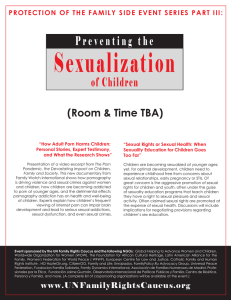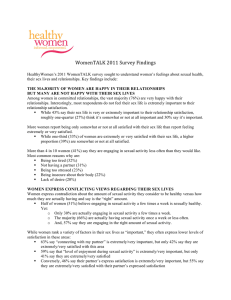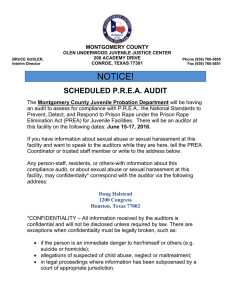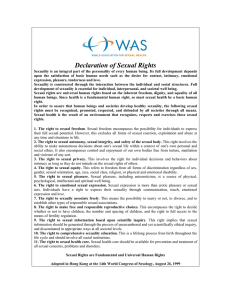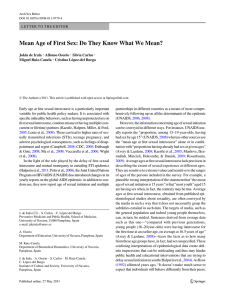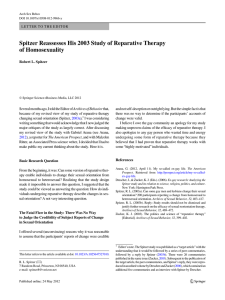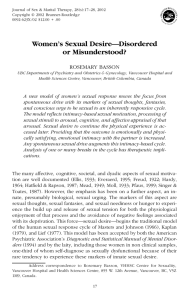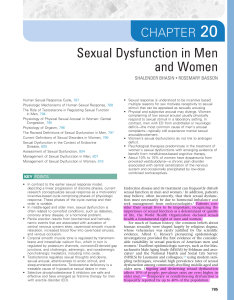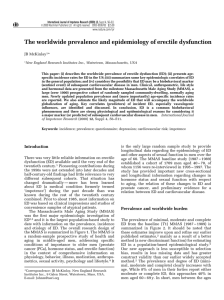Anuncio
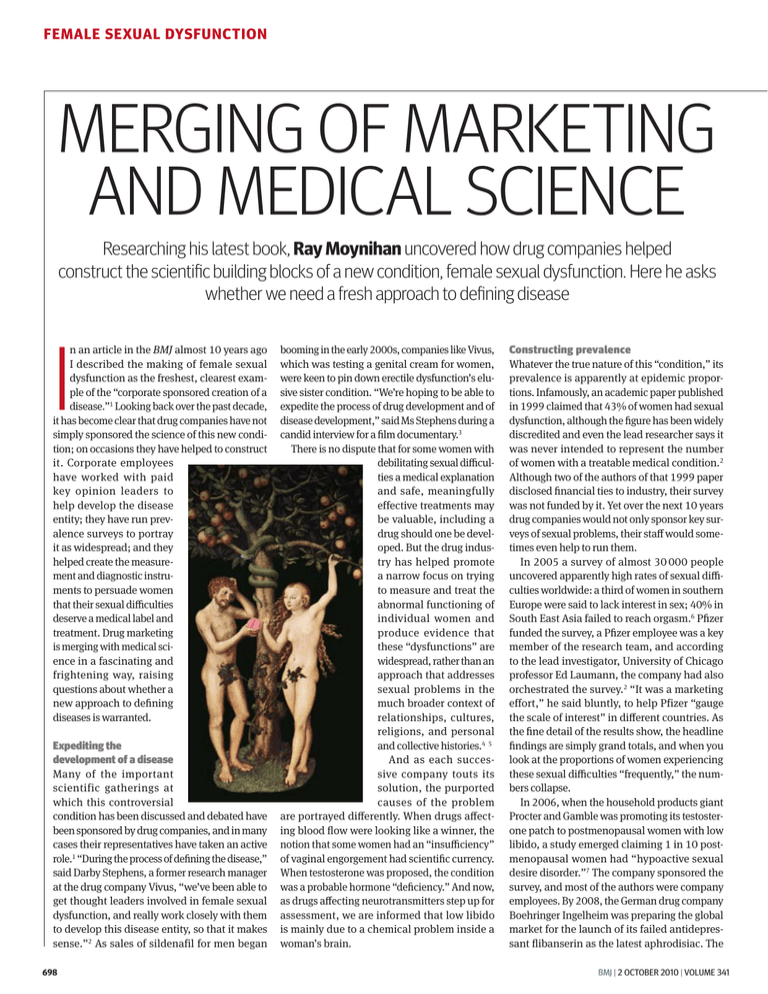
FEMALE SEXUAL DYSFUNCTION MERGING OF MARKETING AND MEDICAL SCIENCE Researching his latest book, Ray Moynihan uncovered how drug companies helped ­construct the scientific building blocks of a new condition, female sexual dysfunction. Here he asks whether we need a fresh ­approach to defining disease I n an article in the BMJ almost 10 years ago I described the making of female sexual ­dysfunction as the freshest, clearest example of the “corporate sponsored creation of a­ ­disease.”1 Looking back over the past decade, it has become clear that drug companies have not simply sponsored the science of this new condition; on occasions they have helped to construct it. Corporate employees have worked with paid key opinion leaders to help develop the disease entity; they have run prevalence surveys to portray it as widespread; and they helped create the measurement and diagnostic instruments to persuade women that their sexual difficulties deserve a medical label and treatment. Drug marketing is merging with medical science in a fascinating and frightening way, raising questions about whether a new approach to defining diseases is warranted. Expediting the development of a disease Many of the important ­s cientific gatherings at which this controversial condition has been discussed and debated have been sponsored by drug companies, and in many cases their representatives have taken an active role.1 “During the process of defining the disease,” said Darby Stephens, a former research manager at the drug company Vivus, “we’ve been able to get thought leaders involved in female sexual dysfunction, and really work closely with them to develop this disease entity, so that it makes sense.”2 As sales of sildenafil for men began 698 booming in the early 2000s, companies like Vivus, which was testing a genital cream for women, were keen to pin down erectile dysfunction’s elusive sister condition. “We’re hoping to be able to expedite the process of drug development and of disease development,” said Ms Stephens during a candid interview for a film documentary.3 There is no dispute that for some women with debilitating sexual difficulties a medical explanation and safe, meaningfully effective treatments may be valuable, including a drug should one be developed. But the drug industry has helped promote a narrow focus on trying to measure and treat the abnormal functioning of individual women and produce evidence that these “dysfunctions” are widespread, rather than an approach that addresses sexual problems in the much broader context of relationships, cultures, religions, and personal and collective histories.4 5 And as each successive company touts its solution, the purported causes of the problem are portrayed differently. When drugs affecting blood flow were looking like a winner, the notion that some women had an “insufficiency” of vaginal engorgement had scientific currency. When testosterone was proposed, the condition was a probable hormone “deficiency.” And now, as drugs affecting neurotransmitters step up for assessment, we are informed that low libido is mainly due to a chemical problem inside a woman’s brain. Constructing prevalence Whatever the true nature of this “condition,” its prevalence is apparently at epidemic proportions. Infamously, an academic paper published in 1999 claimed that 43% of women had sexual dysfunction, although the figure has been widely discredited and even the lead researcher says it was never intended to represent the number of women with a treatable medical condition.2 Although two of the authors of that 1999 paper disclosed financial ties to industry, their survey was not funded by it. Yet over the next 10 years drug companies would not only sponsor key surveys of sexual problems, their staff would sometimes even help to run them. In 2005 a survey of almost 30 000 people uncovered apparently high rates of sexual difficulties worldwide: a third of women in southern Europe were said to lack interest in sex; 40% in South East Asia failed to reach orgasm.6 Pfizer funded the survey, a Pfizer employee was a key member of the research team, and according to the lead investigator, University of Chicago professor Ed Laumann, the company had also orchestrated the survey.2 “It was a marketing effort,” he said bluntly, to help Pfizer “gauge the scale of interest” in different countries. As the fine detail of the results show, the headline findings are simply grand totals, and when you look at the proportions of women experiencing these sexual difficulties “frequently,” the numbers collapse. In 2006, when the household products giant Procter and Gamble was promoting its testosterone patch to postmenopausal women with low libido, a study emerged claiming 1 in 10 postmenopausal women had “hypoactive sexual desire disorder.”7 The company sponsored the survey, and most of the authors were company employees. By 2008, the German drug company Boehringer Ingelheim was preparing the global market for the launch of its failed antidepressant flibanserin as the latest aphrodisiac. The BMJ | 2 OCTOBER 2010 | VOLUME 341 FEMALE SEXUAL DYSFUNCTION An advisory committee to the FDA rejected flibanserin for the disorder of low libido in June for failing to measure up to pre-agreed benefits Studies show that Pfizer’s sildenafil made virtually no difference in women with low libido s­ cientific evidence used to support its promotional claims that 1 in 10 women had a ­disorder of low desire came from a study it directly funded.8 All five researchers who wrote up the results disclosed financial ties to Boehringer; one was a company employee, and the lead author a company consultant. The assertions that tens of millions of women had this condition and that there was a massive “unmet need” for treatment was based largely on the answer to a single survey question about whether a woman felt the desire to engage in sexual activity. Around the same time scientific studies conducted without industry funding were coming to different conclusions, questioning, for example, whether a widespread disorder of low desire really existed. One survey in the United Kingdom of over 10 000 people found that although sexual problems were common, persistent problems lasting longer than six months were much less prevalent, and the authors questioned whether a lack of interest should be considered a dysfunction.9 A second study that interviewed over 1000 women found that unlike problems including sexual pain, lacking interest in sex was not something women regarded as a serious difficulty.10 Researchers concluded that reduced desire may be a normal adaptation to stress or relationship difficulties and did not generally require a medical solution. One of the study investigators, Michael King, a professor at University College London, says that although collaborations with drug companies are needed to test drugs, he worries when researchers team up with companies to produce prevalence surveys or diagnostic tools because there is a danger the science and the marketing could get mixed up.2 Industry helps design diagnostic tools The next big scientific building block in the construction of female sexual dysfunction comprises the toolkit to diagnose the condition and ­measure the effects of potential treatments. BMJ | 2 OCTOBER 2010 | VOLUME 341 Procter and Gamble promoted its testosterone patch to postmenopausal women with low libido Again, successive companies have helped create the tools to measure their product’s effectiveness, with the encouragement of the US Food and Drug Administration. The 19 item female sexual function index, published in 2000, was supported by Bayer and Zonagen at a time they hoped to treat so called arousal disorder.11 The sexual function questionnaire was funded by Pfizer, and half of the authors on the 2002 paper describing its development were Pfizer employees, including the lead author. 12 In 2004 Procter and Gamble helped to bring us the profile of female sexual function,13 which was used in clinical trials of its testosterone patch to show minor improvements against placebo—­ statistically significant but of questionable clinical meaningfulness.14 And, most recently, in 2009 Boehringer ­Ingelheim announced the decreased sexual desire screener.15 Unlike other questionnaires developed primarily for use in clinical trials, the decreased sexual desire screener was promoted as a “new, easy to use” diagnostic tool to assess women for “hypoactive sexual desire disorder”—the target condition for Boehringer’s forthcoming drug. According to the company’s press release, the tool “enables clinicians who are not necessarily experts in female sexual dysfunction to diagnose the condition with high accuracy in a few minutes.”15 Two of the six researchers who helped create and validate the tool were Boehringer employees; all the others had financial ties to the company, the lead investigator disclosed ties to more than 10 companies, and the editor in chief of the journal that published the article validating the tool disclosed at the time that he had a contract with ­Boehringer.16 According to Lori Brotto, a ­Canadian psychologist attached to the University of British ­Columbia, German drug company Boehringer Ingelheim has been promoting its failed antidepressant flibanserin as the latest aphrodisiac spending only “a few ­minutes” on diagnosis could result in oversimplifying complex sexual problems and giving women a label that may not be warranted. Raising awareness of “unmet need” Industry is also taking a leading role in “educating” both professionals and the public about this controversial condition. During research for my book Sex, Lies and Pharmaceuticals I discovered that a Pfizer funded half day “­continuing medical education” course was offered to ­hospitals across the United States. It claimed that up to 63% of women had sexual dysfunction and that ­testosterone and sildenafil may be ­helpful, along with behavioural therapy. Procter and Gamble also funded a course, delivered by company linked opinion leaders, that had the explicit objective that attending doctors should know the “rationale for testosterone use” in women with ­hypoactive sexual desire disorder. Later, Boehringer ­co-sponsored a website called Female Sexual ­Dysfunction Online, where 80% of the educators disclosed ties to drug companies, including the professor who peer reviewed the site. Pfizer declined a request to be interviewed about female sexual dysfunction, but in a written statement explained it had “conducted a number of studies over the past 15 years designed to understand the causes and nature of FSD [female sexual dysfunction] and its impact on women.” In relation to its financial ties with doctors and others, Pfizer stated that it works with professional and patient organisations, to help efforts that “strengthen communities and work towards a healthier world.” Both Boehringer and Procter and Gamble, which sold its drug business in 2009, declined to be interviewed for my book. “The assertion that tens of millions of women had this condition was based largely on an answer to a single survey question” 699 FEMALE SEXUAL DYSFUNCTION “Although the drugs have so far failed, the edifice of scientific evidence about the condition remains in place” As the planned 2010 launch of its desire drug, flibanserin, approached, Boehringer’s “educational” activities went into overdrive. It hired multiple public relations firms worldwide to try to shape public debate, it hosted closed door meetings with paid experts, it helped fund a documentary about desire, and it sponsored a high profile new website called SexBrainBody, widely promoted in the US media in the weeks leading up to a June meeting of the FDA to assess flibanserin as a treatment for low desire. The media campaign starred a former Playboy model turned television celebrity and emphasised that millions of women were suffering in silence with a disorder of low desire that was largely due to problems with their brains. In May this year a television programme featured a company linked expert saying sexuality is “more about the brain” than anything else, another segment had a researcher explaining that 1 in 10 women had “hypoactive sexual desire disorder,” while a third expert claimed the desire disorder “affects about 30% of women.” Ultimately, at the public hearing in June, the advisers to the FDA rejected flibanserin, which failed to measure up to pre-agreed benefits while carrying the risk of serious adverse events.17 Two months later the FDA sent Boehringer a “complete response letter,” and the company told the BMJ it cannot comment on the future of flibanserin until it has undertaken a “detailed evaluation” of that letter. Procter and Gamble’s testosterone patch was rejected in 2004 in the United States, largely over fears of long terms risks of cancer and heart disease.18 Although the patch was subsequently approved in Europe, independent assessment agencies have recommended against its use because of questionable benefits compared with placebo and serious risks.2 Pfizer’s sildenafil was also 700 pulled from the race after studies showed virtually no difference from placebo. Although the drugs have so far failed, the edifice of scientific evidence about the condition remains in place—constructed with corporate money and often with help from company staff—creating the impression, reinforced constantly in promotional materials, that there is a massive “unmet need” for treatment. The same advisers who in June this year rejected flibanserin for the disorder of low libido were supportive of more work to tackle what they described as this “health issue.” With more experimental drugs in the pipeline, the drug industry shows no signs of abandoning plans to meet the unmet need it has helped to manufacture. Indeed, at a drug company funded conference in Paris last year, high profile researchers with financial ties to industry announced proposals to change fundamentally the way drugs for female sexual dysfunction are tested, which would make it easier for pills and patches to show benefits against placebos.2 New ways to define disease? Rather than national public health priorities being distorted by perceptions of unmet need promoted by well paid celebrities, perhaps it’s time to reassess the way in which the medical establishment defines common conditions and recommends how to treat them. Out in the medical marketplace life’s ups and downs are being transformed into blockbuster conditions such as sexual dysfunction, overactive bladder, and adult attention deficit disorder, while minor increases in the risk of future illness are portrayed as an ever increasing range of pre-conditions, including prehypertension, prediabetes, and pre-osteoporosis. The pattern is clear: opinion leaders linked to companies selling solutions meet to revise and refine the definitions of conditions for which the latest treatments are then aggressively promoted, and, inexorably the boundaries of potentially treatable illness are widened. The making of female sexual dysfunction has attracted so much public scrutiny, in large part because of the work of New View, a global network including academics, clinicians, and feminists that since 2000 has been exposing industry’s role and offering an alternative, broader understanding of sexual difficulties.5 The group has helped enhance the scepticism of media coverage, informed a wider public debate about the uncertainty surrounding this condition, and also influenced developments within the small circles of sex research. The current proposals for a revision of the definitions of female sexual dysfunction put more emphasis on relationships, raise the threshold for diagnosis, lower the estimates of prevalence, and abandon the entity currently known as “hypoactive sexual desire disorder.” 19 What we have here is a case study of civil society responding to the merging of marketing and medical science, provoking the need for a wider debate about reform of the way human disease is defined, developed, and promoted to the public. How many of the thresholds for the prescription of powerful drugs have been lowered to such an extent that we are inadvertently doing more harm than good? What is the global opportunity cost of medicalising and medicating tens of millions of wealthy healthy people with minor ailments or low risks of distant illness? Shirley Boles, the Florida woman recently awarded a large payout by a New York court because she developed osteonecrosis of the jaw after taking alendronate for many years, was originally diagnosed with only pre-osteoporosis— the “condition” of being at risk of being at risk of future fracture, which some estimates claim affects half of all postmenopausal women. As leading bodies like the US Institute of Medicine call for much greater independence between the industry and the profession, 20 perhaps it is time to develop new panels to take responsibility for defining treatable illness, made up of people without financial ties to those with vested interests in the outcomes of their deliberations and much more broadly representative of the wider public. The move towards evidence informed health care has enhanced the scientific evaluation of the risks and benefits of interventions. Perhaps it is time to apply a similar rigour to the claims about the nature and extent of the conditions those interventions are targeting and start the slow process of untangling the marketing from the medical science. Ray Moynihan conjoint lecturer, University of Newcastle, Newcastle, Australia www.raymoynihan.net This article is based substantially on research for the book Sex, Lies and Pharmaceuticals, cowritten with Barbara Mintzes. Competing interests: The author has completed the unified competing interest form at www.icmje.org/coi_disclosure.pdf (available on request to him) and declares no support from any organisation for the submitted work; RM received a publishing advance to write Sex, Lies and Pharmaceuticals, and he teaches and lectures on the public health problem of disease mongering at universities and conferences around the world. Provenance and peer review: Commissioned; not externally peer reviewed. References are availiable on bmj.com Cite this as: BMJ 2010;341:c5050 BMJ | 2 OCTOBER 2010 | VOLUME 341 FEMALE SEXUAL DYSFUNCTION COMMENTARY Sandy Goldbeck-Wood Female sexual dysfunction is a real but complex problem When the desire for sex goes persistently data.4 5 His research clarifies, helpfully, both the missing, a few women may be untroubled but conflicts of interest at work and the relative paucity many become unhappy. Some are unhappy of good quality evidence for pharmacological because they miss the pleasure, physical release, solutions to women’s sexual problems. However, and emotional intimacy that sex can provide his argument that female sexual dysfunction is or because a lack of sex stands in the way of an illness constructed by pathologising doctors having children. Sometimes their unhappiness under the influence of drug companies will fail to is social or relational: because they fear hurting, convince clinicians who see women with sexual rejecting, frustrating, angering, dysfunction, or their patients. and perhaps even losing their Women who have struggled to partner. Many endure sexual overcome the psychological and unhappiness for long periods cultural barriers to requesting help alone, feeling too embarrassed, with their sexual difficulties will not ashamed, unentitled, welcome the argument that they mistrustful, or hopeless to ask are to be “left alone”; patronising for help. It is difficult to speak normalisation will serve them no to a strange doctor about such better than ineffective medication. “Faced with a private distress; more difficult woman in tears still given that many fear Multidimensional solutions whose libido has embarrassing their doctor.1 2 The problem is one of disappeared and So women who consult oversimplification. Sex is, par who is terrified doctors about sexual problems excellence, a biopsychosocial are those for whom the experience, and attempts to of losing her unhappiness has become so split these elements, however partner, doctors intractable, or is causing so intellectually or politically can feel immense many physical or relational convenient, are doomed to fail. pressure to provide Many factors can contribute to low problems, that they are forced an immediate, into the open. Some present a libido, few of them treatable with sexual problem directly, others drugs. Traumatic experiences, effective solution” indirectly through secondary physical or mental illness, symptoms such as depression, recurrent vaginal unexpressed feelings within a relationship, discharge, or chronic pelvic pain.3 pressure to conform to religious or media ideals Faced with a woman in tears whose libido of womanhood, or general unhappiness in wider has disappeared and who is terrified of losing life can all disturb a woman’s relationship with her partner, doctors can feel immense pressure her partner, or with her own body. It is welcome, to provide an immediate, effective solution. therefore, that the Diagnostic and Statistical Given that most doctors understand more about Manual of Mental Disorders is revising its biological illnesses and treatments than other definitions of female sexual dysfunction to reflect possible causes of sexual difficulty and that most contextual factors,4 and unsurprising that the best medical research is biological in focus, it is not available evidence (levels 3, 4, and 5) supports surprising that we often reach first for oestrogen the use of a multidisciplinary or biopsychosocial creams, testosterone patches, phosphodiesterase approach to treatment.6 5 inhibitors, antidepressants, or dilators— The methodological challenges to such anything halfway plausible to defend us from research are considerable. Experts from disparate the naked embarrassment of our therapeutic disciplines such as gynaecology, psychotherapy, impotence. It is easy to see how the pressure sociology, or psychiatry are divided by history, for immediate solutions, combined with our culture, language and research methodology, and biological bias and offers of research funding, sometimes by mutual suspicion and competition.7 leads to the kind of collaboration with the drug Outcome studies are notoriously difficult to design industry that has worked well for other illnesses, and conduct in ways that meet high evidence despite its relative inefficacy in this area. standards while respecting the complexity of Moynihan’s research points to an improperly sexual life.8 9 Many studies have focused narrowly intimate research relationship between industry on genital function or performance, for example, and clinicians, distorting the research agenda and and overemphasised frequency of various casting doubt over even the most basic prevalence sexual acts, neglecting more subtle measures BMJ | 2 OCTOBER 2010 | VOLUME 341 of satisfaction or health related quality of life. Even defining a good treatment outcome can be challenging. More studies of interdisciplinary approaches are needed, using methods that allow subjective, lived experience to be studied, rather than dismissed as a contaminant.10 Moynihan points away from overinvestment in pharmaceutical solutions that ignore both aetiology and evidence. His book points clinicians, researchers, and funding bodies towards the most realistic treatments using the most appropriate methods—those which respect the biopsychosocial complexity of the problem.11 We owe these women something more respectful than ineffective medication or patronising false reassurance. At the least, this may be an honest acknowledgment of our, and medicine’s, limitations to deal with a real problem. At best, we can offer them the interdisciplinary treatments most likely to help. This means leaving the comfort zones of biology, medication, and familiar research methodologies, and designing studies which reflect the complexity of sexual life, and respect lived experience. Sandy Goldbeck-Wood associate specialist in psychosexual medicine, specialty doctor in obstetrics and gynaecology [email protected] Competing interests: The author has completed the unified competing interest form at www.icmje.org/coi_disclosure. pdf (available on request from the corresponding author) and declares no support from any organisation for the submitted work; no financial relationships with any organisation that might have an interest in the submitted work in the previous three years. She works as a specialist doctor in psychosexual medicine, within the NHS and with a small private practice. She is a member of the Institute of Psychosexual Medicine (IPM), a trainer for the IPM, and edits the IPM’s journal, IPMJ. She also has training in psychotherapy, and a longstanding interest in psychosomatic aspects of sexual and reproductive health. References are available on bmj.com Cite this as: BMJ 2010;341:c5336 Where to go for information on better help •Institute of Psychosexual Medicine (www.ipm. org.uk)—Provides training in psychosexual medicine for doctors in the UK •British Association of Sexual and Relationship Therapy (www.basrt.org.uk)—A specialist charity that provides information on sexual problems, access to psychosexual therapists, and useful resource links •British Association for Behavioural and Cognitive Psychotherapies (www.babcp. com)—Information on training, accreditation, supervision, and access to cognitive behavioural therapists in the UK, with links to similar organisations in other countries •British Society for Sexual Medicine (www.bssm. org.uk)—Promotes research and education on sexual dysfunction. Membership allows access to peer reviewed publications 701
